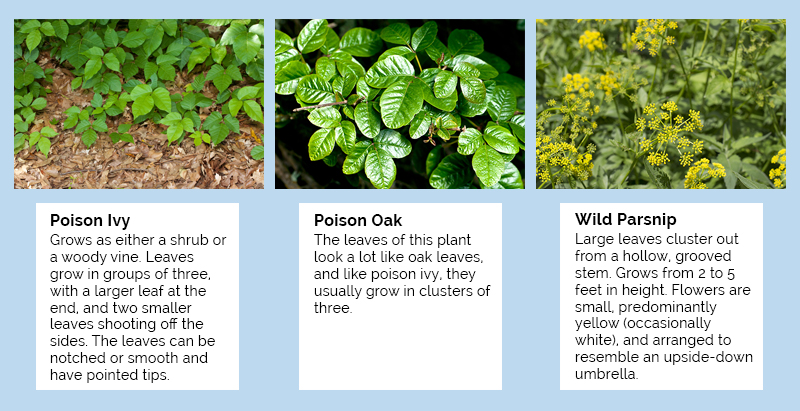




Today's Medicine
Poisonous Plants of Summer


Perhaps you’ve heard the saying, “Leaves of three, let them be.” It’s a great little warning for a summertime nuisance that could leave you very uncomfortable: poison ivy. But do you know how to identify it … or any of the other growing greens that could cause you lots of pain?
Starting to spread
Itching and rash from poison ivy (and its evil twins poison oak and sumac) is something we Methodist Physicians Clinic doctors are seeing a lot of these days. That’s because springtime has them “springing” back to life, and the vines are running rampant. Later this summer, Iowans and Nebraskans need to watch out for another dangerous weed called wild parsnip. It packs a dangerous punch.
Identifying dangerous plants
Poison ivy can look like either a vine or a shrub that grows low to the ground. The tell-tale sign are its signature glossy leaves which grow in clumps of three. The plant may have yellow or green flowers, and white to green-yellow berries, depending on the season.
They don’t grow much around here, but you should know that leaves on poison oak can grow in clumps of three to five, and has leaves that look more like oak leaves. Poison sumac grows as a shrub or small tree, and in very wet areas. Each stem contains seven to 13 leaves arranged in pairs. It has the potential to cause a more severe rash than either poison ivy or poison oak.
Wild parsnip is a yellow, four foot tall plant looks like a dill plant or Queen Anne’s lace, but it’s the reaction it causes to your skin that sets it apart. You will find this invasive weed in many road ditches and rural areas.

What makes these plants such a problem?
Poison ivy and its nasty relatives emit an oily substance called urushiol. Getting it on your skin can cause a severe, itchy rash that can last anywhere from 10 to 15 days or longer.
Coming into contact with wild parsnip can cause burns, blisters and welts within 48 hours of coming into contact with the plant. The burns from wild parsnip are similar to second-degree sunburns, and can cause painful rashes and raised blisters.
What should I do if I touch these plants?
- Wash right away using soap and water.
- Use over-the-counter calamine lotion and hydrocortisone cream when your skin turns into an itchy rash.
- With wild parsnip, protect your skin from sunlight for at least 48 hours.
Should you go see the doctor?
When it comes to wild parsnip, any reaction warrants a trip to the doctor. With others, it depends on the severity of the problem.
See the doctor if the over-the-counter medicines aren't helping or if the rash continues to spread. You should also see the doctor if the rash covers a large amount of surface area on your skin or if it causes any breathing problems.
The doctor may prescribe an oral or topical steroid to help ease the itching or slow the spread of the rash. They may also give you a steroid injection to help things along. There are also prescription strength anti-itch medications that may provide some relief.
An ounce of prevention …
When it comes to these plants, it’s all about prevention and avoidance:
- Learn how to recognize these plants so you can avoid contact with them.
- If entering a wooded or grassy area, wear protective clothing that covers the skin, including gloves, long sleeves, long pants and boots.
- Do not burn poison ivy, poison oak or sumac, as this can release urushiol into the air. If inhaled, it can irritate your lungs and airway.
- Remove the plants if they are growing near your home. Be sure to wear protective clothing and gloves.
- Thoroughly wash any objects or clothing that may come into contact with these plants. The oils can rub off onto them and then onto you, causing a rash from secondary contact.
- If a pet has been exposed to these plants, wear protective gloves and give them a bath.
If you have any questions or concerns about a rash, talk to your Methodist Physicians Clinic primary care provider.


